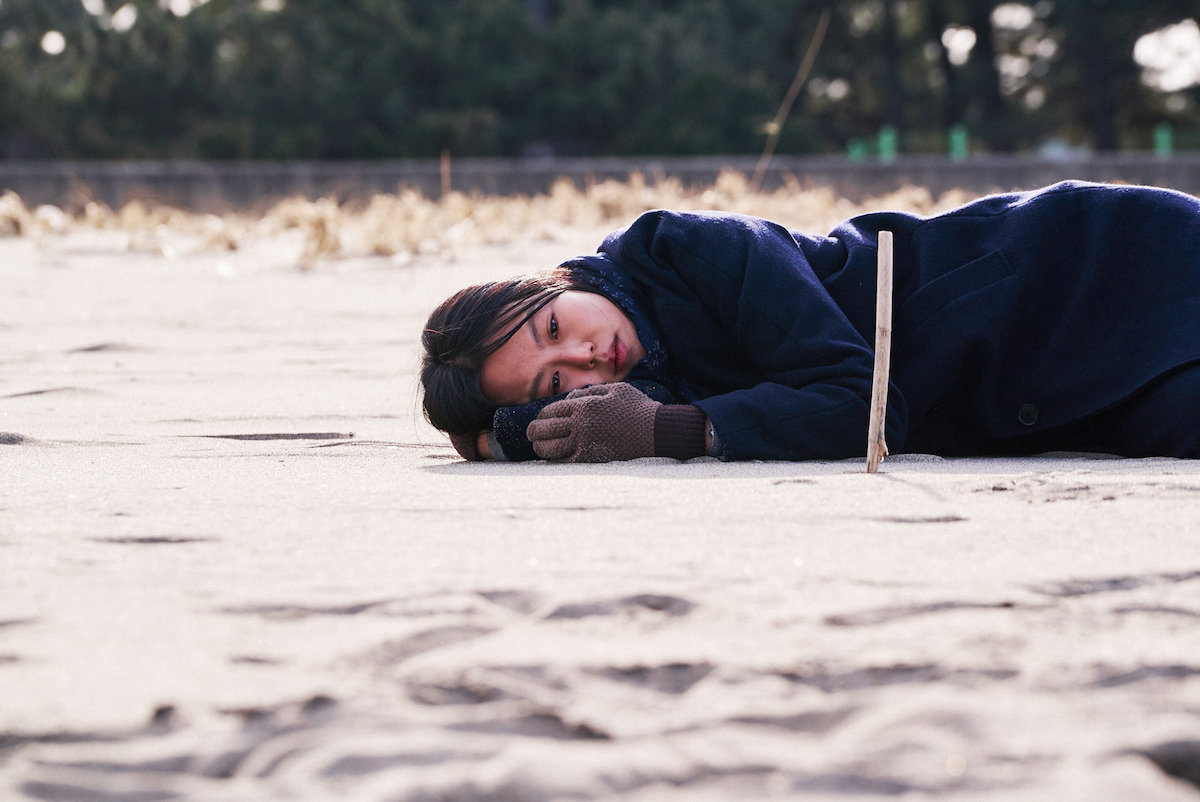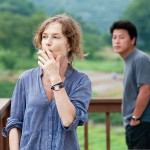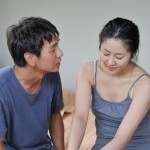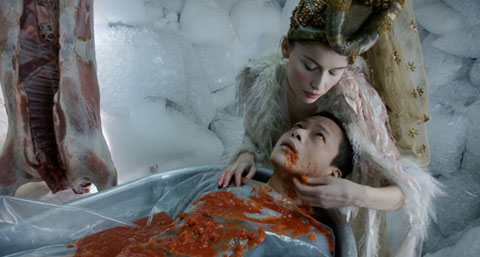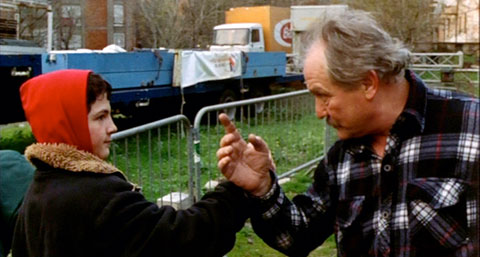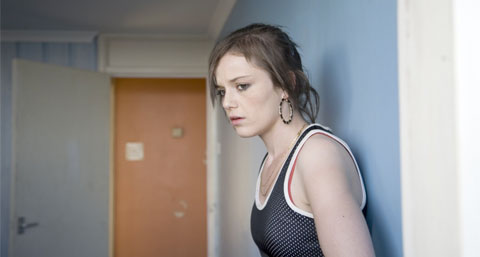This interview was originally published at Mubi.
* * *
Hong Sang-soo has a reputation for being a tricky interview, and he knows it. In Claire’s Camera, one of his three films that premiered in 2017, a Korean director who’s in Cannes to promote his latest movie tries to back out of the two press engagements on his schedule. “You need to do that much,” his sales agent cajoles him. “It’s not that much.”
Hong, likewise, has been known to cancel or reschedule interviews and to give terse and seemingly disinterested answers. He tends to talk about his production methods in the most straight-forward terms and dismisses questions about authorial intent. Asking him to interpret his own work is a fool’s errand. “I get up at 4:00, I smoke, and something I didn’t expect comes to me,” he told me.
I met Hong in the bar of the Loews Regency on October 9th, the afternoon after his other two new films, On the Beach at Night Alone and The Day After, had their first public screenings at the New York Film Festival. He was tired from a late night but amiable and generous. My strategy was to begin by raising an under-discussed aspect of his career—that Hong’s early training in interdisciplinary art programs, rather than an industrial film school, had set him down this road of unconventional production techniques. From there he took the discussion in a few unexpected directions. There are miracles, indeed.
On the Beach at Night Alone opens November 17 in the U.S. Read our review and interview from Berlin. See also our reviews of Claire’s Camera and The Day After from Cannes.
* * *
HUGHES: I’ve heard you tell a story that you stumbled into filmmaking as a college student, that you were bored and decided to transfer to the film department on the advice of a friend. Is that right?
HONG SANG-SOO: I was in limbo. I didn’t take the entrance exam. And then this playwright and theater director, my mother’s friend, came to our house. They had a small party. Everyone left except for him because he was drunk. He was sitting on the sofa alone. This was around 2:00 or 3:00 A.M., and I was cleaning up. I was fond of him because he was a character. I was sitting next to him and he said, “What are you doing?” “I’m doing nothing.” [laughs] He said, “Maybe you should try the theater? Maybe you can do it?” He was just saying it. I don’t know if he really meant it. He was drunk. But when he left, I started thinking, “That sounds very nice.” So I prepared for the entrance exam for a couple months and then I entered the theater department. But unfortunately I had a problem with the senior students, so I couldn’t go on being in the department.
HUGHES: What do you mean “a problem”?
HONG: We had a severe problem. [laughs] In those days, especially in the theater department, there was a hierarchy between senior students and junior students. It was very strict. But it happened to be a theater and cinema department, and when I looked at the film students, they didn’t have the same hierarchical relationships. So I thought, “Maybe I’ll try film.”
HUGHES: Was it just film production or did it also include film history?
HONG: Production. There were film history courses, too, but I never meant to become a scholar.
HUGHES: Were you a cinephile before then?
HONG: I only watched movies on weekends on TV. Hollywood films.
HUGHES: You eventually went to the California College of the Arts and the School of the Art Institute of Chicago, which are both interdisciplinary film programs.
HONG: Yeah, they encourage you to study the other majors. That was another accident. One day I saw this newspaper article about how they’d just allowed a student to go abroad even though he didn’t fulfill [his compulsory] military service. He could study abroad, come back, and do the military service afterwards. I was in my second or third year in the Korean university when I saw this small article. I started looking for funds that I could use for going abroad. First I went to some institution that helps you find a school and I said, “I want to go abroad and study film. Any college is fine as long as it’s cheap!”
And then I went to this person I knew who is a friend of my mother. He’s another character. He was a monk and then became a film producer. He was also a writer, and I liked him, and I had this feeling that he might help me out. So I went to him and said, “I want to go abroad and study film, and if you help me now I will help you later. Can you do that?” And he said, “Yes.” So I got funds from him for studying abroad.
HUGHES: Why is your mother surrounded by such interesting people?
HONG: Because she likes interesting people, talented people. [long pause] Anyway, I was very lucky to get the answer “yes.”
HUGHES: Most film schools in America train students to play a part in a larger production machine. The schools you went to …
HONG: Had nothing to do with that.
HUGHES: Did you meet filmmakers in those schools who showed you other kinds of production models?
HONG: In both departments, most of the teachers were filmmakers themselves. It was good to see that. During vacations they would make their own films. Most of them were experimental filmmakers. I liked them and I really enjoyed talking to them. They were a great help. They encouraged me a lot. I was lucky again.
HUGHES: Did you see that as a model to follow? Could you imagine yourself teaching and making films during vacation?
HONG: No, I never thought of becoming a teacher. Now I’m teaching at a university, but at the time I didn’t have any concrete plans.
Until I was 27, when I saw Diary of a Country Priest, I never thought I would make a feature-length narrative film. I always thought I was going to make experimental films, very short films, strange ones. [laughs] That was the vague plan. It was all I had. And then I saw Diary of a Country Priest and thought it was so beautiful. That film was something, really. It gave me hope: If a film can do this then I can learn how to make a narrative film.
HUGHES: Where did you see it?
HONG: In Chicago. In a seminar.
HUGHES: Was it a Robert Bresson seminar?
HONG: No. They were showing many films. This was one of them. And so I started reading about how to write a script.
HUGHES: When did you first see Luis Buñuel’s films?
HONG: Also in Chicago. Richard Peña, who used to be the director here of the New York Film Festival, was a lecturer there and taught a course about Buñuel. I was Pena’s graduate assistant for the course, so I saw most of Buñuel’s films and really loved all of them.
HUGHES: Years ago, after a screening of Claire Denis’s L’intrus, I was discussing the film with a friend and he said, “This is what I learned from Buñuel: It’s pointless to ask, ‘Is it real or is it a dream?’ Who cares? It’s cinema.” I think about that often when I watch your films. At the end of part one of On the Beach at Night Alone, Kim Min-hee’s character is abducted by a stranger, with no explanation. I assume you don’t care how that’s interpreted.
HONG: It doesn’t matter. As long as I feel it’s okay, it’s okay. Everything is illusion, realistically speaking. Everything, everything we see, we feel, we imagine, everything is real and at the same time is fake. It’s an illusion. The distinction is not that important.
HUGHES: Do you mean in life? Or just in cinema?
HONG: Okay, when you deal with practical things, we all have to speak the same language, so we pretend to [share the same reality]. But really, really, really [laughs] realistically speaking, everything’s okay, is how I feel. Know what I mean? Everything is illusion, everything is grace. But when you deal with everyday life you have to speak the same language in order to communicate and get what you want. It’s dualistic.
HUGHES: Did you intentionally just quote Diary of a Country Priest? “Everything is grace.”
HONG: Oh, yeah, yeah. Maybe one of the reasons I liked that film when I saw it for the first time was because of that dialogue at the end. It touches me deeply. It’s what I keep saying to myself every day.
HUGHES: It is all grace.
HONG: Everything. Whether we acknowledge it, it is grace.
HUGHES: This is a dumb and obvious question, but is that what your characters are seeking?
HONG: Kim Min-hee’s character [in On the Beach at Night Alone] says something about this, about praying to God. Except for that character, I’ve never written someone who says this, my attitude, directly. I was being careful. But now I’ve changed, I guess, a little bit. With Kim Min-hee I thought, “Maybe it’s okay to say these things directly.”
HUGHES: You talk often about how you begin each film with certain actors in mind. You see some quality in them that you think you can work with. As I’ve watched these recent films, I’ve tried to figure out what it is that interests you about Kim Min-hee when she’s on screen. In that first long scene in Claire’s Camera, when she’s being fired by her boss, her body language is beautiful. She rolls her shoulders forward and leans into the conversation.
HONG: Yes, I find it very beautiful too.
HUGHES: Do you stage that?
HONG: No, no, as long as they are faithful to the dialogue I gave them, each take is their own. They are free to interpret the dialogue. I try to give them a minimum amount of instruction. Only when they are going in the wrong direction [laughs], I tell them, “No, no, that’s not the way to go.” Otherwise, I let them do whatever they want to do.
Each take is very different, usually. Each take is a small universe. That’s why I want to have unbroken takes, because each one is very different. So when they finish [a great take] I don’t even want to talk about it. They do these small things. There are miracles. I don’t want them to repeat that from a reverse angle.
HUGHES: With that shot, though, you’ve chosen where to put the camera.
HONG: Yes.
HUGHES: And it’s slightly behind Kim Min-hee. We don’t see her entire face until the very end of the take, when she turns toward the dog on the ground. Much of the drama is in her stooped shoulders.
HONG: Yes.
HUGHES: I was also struck by another long take in Claire’s Camera, when the sales agent is talking to the director in a cafe. Midway through the scene a bus or a truck passes by the window. We don’t see it, but it briefly blocks out most of the natural light. It’s an exciting moment for me as a viewer. The image suddenly becomes charged in some new way.
HONG: I plan few things but I expect—secretly, all the time—that something will happen during the take. Could be a noise, could be the change of light from a truck passing by. [The actors’] interpretation of each take is always fresh for me. Sometimes they emphasize this line but the next take they emphasize another line. They’re in harmony. I really love watching these changes between the different takes. I allow all of these things to happen, and if I like the result I keep it.
HUGHES: Is there ever any doubt about which is the right take? Or do you always know immediately?
HONG: I kind of know. I usually have one or two takes that I keep, that I think are okay, and when I return to my office I look at them and decide.
HUGHES: I saw Claire Denis’s new film, Let the Sun Shine In, yesterday, and it felt like her version of a Hong Sang-soo film.
HONG: [laughs] Another interviewer mentioned that. I haven’t seen it yet.
HUGHES: I only mention it because in an interview for the film she said she told her screenwriter, Christine Angot, “We don’t have much time. We don’t have much of a budget. Let’s film your words.” That approach is out of the ordinary for her but pretty typical for you. Especially in the recent films, your characters barely exist outside of conversation.
HONG: I always have a few scenes of a character alone, walking. I like them because there’s a different light outside, or trees are moving. Even if the scenes are short, they’re very precious. I’ll have long conversation shots and in between there’s a small insert or they’re walking on the street. Just that much is precious to me.
HUGHES: Is that rhythm designed ahead of time?
HONG: No, I just keep shooting in chronological order. I write based on what I wrote the day before.
HUGHES: There are several beautiful images in the new films. For example, the shots of Kim Min-hee on the beach. You could have shot those scenes somewhere else, in a cafe or in front of a brick wall. How important is beauty when you’re designing a scene?
HONG: If the image reminds me of a cliched “beautiful image,” I try not to use them. When I decided to [make a film] in Cannes I knew I wanted to shoot something on the beach. Cannes is known for the beach, so I knew I would shoot something important there. If it turned out to be a beautiful scene, that’s okay. I’m satisfied with it, but I don’t aim to repeat what others say is a “beautiful scene” intentionally. It has to come naturally and out of necessity.
HUGHES: Would a clichéd image break your films?
HONG: I make a joke to my cinematographer all the time, “Maybe this is too beautiful?” [laughs] I guess my frame, my cinematography, is neutral. I don’t know if this expression is exactly right, but I want to contain what is going on in the most economic frame. Following them in the most economic way has a certain beauty. That’s all I’m aiming for. But sometimes it happens that the scenery is so beautiful [that it necessitates that I] shoot at a low angle to show [Kim’s] back on the same level, and it’s beautiful. That’s okay. I can handle that. But I don’t aim for a so-called beautiful scene. Never.
HUGHES: Because your films follow that long take/short aside rhythm that you described earlier, I’m always intrigued by the images that break the pattern. There’s a shot in Claire’s Camera when Kim Min-hee and Isabelle Huppert are looking at a large mural. They’re both quite small and cut off at the bottom of the frame.
HONG: That’s the place where we always stay together—the crew, everyone. I noticed the mural has three ladies and I wondered, “Maybe this has something to do with my films?” [laughs]
HUGHES: Since you’re now shooting mostly in long takes, do you ever regret not getting to use some of the other tools of the trade? Do you miss close ups?
HONG: I have a close up! I can zoom in any time I want.
HUGHES: I don’t remember seeing a tight close up for some time.
HONG: [smiles] You will see it. The one I just shot.
HUGHES: Do you feel that you have to preserve those shots for particular occasions?
HONG: It just comes naturally. I’m not aiming for any effect. I’m just following my instinct.
HUGHES: The final, long conversation in On the Beach at Night Alone is staged as a group scene, but because it’s a dream, presumably it could’ve been written as a conversation just between Kim Min-hee’s character and the film director.
HONG: It just came out that way.
HUGHES: It’s interesting, though, because the presence of other people changes the dynamic. She wants validation from the director. He wants validation from everyone at the table.
HONG: It shows who he is. Maybe we have hints of why the relationship didn’t work. All of these things can be perceived by this group of people—how they interact with each other, things like that. But when I wrote the scene, I didn’t intend that. It just came out like that.
HUGHES: Are there still moments when you’re surprised or especially delighted by something that, ten minutes earlier, you’d had no intention of writing?
HONG: Every morning I’m surprised! Every morning, after one or two hours, something really fresh comes to me, and I’m surprised. “Wow!” [laughs]
HUGHES: Is that the fun part?
HONG: Of course. It’s the most intense part. I enjoy it so much.
HUGHES: Do you think that process has helped to teach you how to recognize grace around you?
HONG: I think it’s all connected. I want to create something right now, in the moment, spontaneously. Sometimes I think about why I do this, writing in the morning, and I’ve come up with this explanation: it’s my temperament. I remember even when I was young, I would have a good time with my friends and then one would say, “Let’s meet again this weekend.” I’d say “no.” I didn’t want to have a preparation period. It’s my temperament.
HUGHES: The way you describe your writing process sounds not like prayer, exactly, but like a kind of spiritual practice.
HONG: I get up at 4:00, I smoke, and something I didn’t expect comes to me. I hurry to finish everything, I retouch it, print it, and call the actors to set. And after two hours I can see them acting what I wrote.
HUGHES: It’s a miracle every day.
HONG: It’s so nice.
